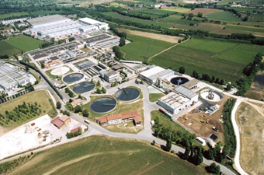Water treatment

Water is a resource of primary importance, distributed unevenly in the Italian territory, abundant in the north and the scarce in the south. The civil, industrial and agricultural uses require a resource quantity that, especially in summer, might not be available.
The nature predominantly hilly and mountainous of the territory also entails hydrogeological issues, due to the excessive waterproofing of urban areas and overly abundant rainfall, producing landslides and soil subsidence.
For this reason, Italy has developed a dense network of canalization of surface water and a system of pickup and transport of ground waters by pipelines, realized with a redundancy criterion (in order to avoid, as far as possible, the interruption of the delivery due to accidents and maintenance), but also a criterion of economic viability, due to the fact that part of the infrastructure are built and managed by private companies.
Urban and industrial water purification has a fundamental role, not only in the prevention of soil contamination, but also for the ability to reuse the purified water in the context of civil and industrial uses.
The need to achieve environmental sustainability, imposed both by legal constraints and by a growing market demand of "green" products, has led to the creation of cutting-edge purification systems for many industries, often recognized as BAT (Best Available Technology ) by the European Union.
Excellent results have been achieved in the field of leather processing and in the chemical industry.
Italy produces 20% of the leather of the World, for a value of more than one billion euro per year; it is an important industry for the Italian manufacturing, which has more than 1,300 factories distributed in four industrial clusters.
Processing of hides is particularly pollutant, because of the use of chemical agents, in some cases toxic, and the use of trivalent chromium which, in the case of an oxidation process, would become hexavalent and, therefore, strongly carcinogenic; processing of hides, in addition, involves the emission of particularly unpleasant and intense odors.
The environmental performance of waste water treatment systems of Italian tannery industrial clusters exceeded the European BAT benchmarks, treated water achieves quality to be authorized to enter into rivers, while different technologies have been used for the treatment of sludge, which can be used to produce energy or converted into fertilizers.
After the Second World War, in Italy, the chemical industry has been highly developed, particularly in the petrochemical, pharmaceutical, paints and rubber-plastic. The waste water from these industries have characteristics that cannot be purified in biological systems, but require the chemical-physical treatments..
For this reason, the chemical industry has committed to develop technologies and patents for the treatment of their own wastewater, becoming, therefore, reference points for whole industrial clusters and, today, they have been adopted all over the World.
Infrastructures have been studied and realized with the purpose to purify the industrial and urban waste in order to be used for industrial and civil purposes in place of drinking water; these infrastructures have also been designed to support the remediation process and rehabilitation of contaminated industrial areas.
One example is the industrial and port area of Venice, that has been for decades one of the largest chemical and petrochemical parks in Europe, causing a strong contamination for soil, groundwater and lagoon.
Over the past decade, works for soil remediation have been launched and implemented, which have, as a crucial factor, the water treatment system. The problem has been addressed as a whole, taking into account all the needs, and the infrastructure that has been realized allows the collection of industrial waste water and surface water of the lots into a system which conveys to two purifiers, which in turn convey the treated water in the wider area of constructed wetlands ever built in Europe.
The phytoremediation area allows to obtain two main advantages, on the one hand it helps the natural balance of the lagoon, the other it completes the purification treatment of the water, which is then picked up and conveyed again to the industries, to be use in cooling systems and manufacturing cycles. In this way, the Venice industrial park has stopped to pick up water from the aqueduct.
Constructed wetlands is a tool that is becoming more and more important in Italy, because it allows to enable locally purification systems and water reuse.
It's, in fact, used for the purification of leachate of landfills, but also for the purifying of urban waste water, which, in a closed circuit, limited to a residential block, allows the reuse of water in sanitary installations or for irrigation, significantly reducing the consume of water from the aqueduct.